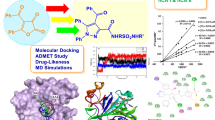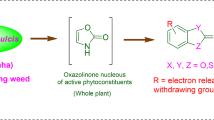Abstract
Vinblastine and its related compound vincristine are important mono terpenoid indole alkaloids accumulated in the leaves of Catharanthus roseus (Madagascar periwinkle). They serve as major anticancer drugs. Vinblastine is formed by the condensation of vindoline and catharanthine. The vindoline moiety is derived from tabersonine via vindoline biosynthesis pathway. The reaction sequence from tabersonine to vindoline is now well established and the enzymes involved in this pathway are identified. However, to date, the structures of the enzymes involved in the vindoline biosynthesis pathway are not known, leading to limited mechanistic understanding of the substrate binding and catalysis. The purpose of this work is to provide structural insight regarding all the steps of the vindoline pathway via rigorous homology modeling, molecular docking, and molecular dynamics analyses. Substrate and cofactors required for each step were docked onto the computationally built and validated three-dimensional (3D) model of the corresponding enzyme, and the catalytic reaction was analyzed from the structural point of view. Possible binding modes of the substrates and cofactors were generated and corresponding binding residues were identified. Enzyme-substrate models were verified based on structure evaluation methods and molecular dynamics based approaches. Findings of our analysis would be useful in rational designing of these important enzymes aimed toward bio-production of vindoline.








Similar content being viewed by others
References
Negi A, Singla R, Singh V (2014) Indole based alkaloid in cancer: an overview. PharmaTutor 2:76–82
Noble RL (1990) The discovery of the vinca alkaloids--chemotherapeutic agents against cancer. Biochem Cell Biol 68(12):1344–1351
Zu YG, Luo M, Mu FS, Fu YJ, Wang L (2006) Advances on alkaloids in Catharanthusroseus and theirpharmacological activities. Nat Prod Res Dev (18):325–329
Qu Y, Easson ML, Froese J, Simionescu R, Hudlicky T, De Luca V (2015) Completion of the seven-step pathway from tabersonine to the anticancer drug precursor vindoline and its assembly in yeast. Proc Natl Acad Sci U S A 112(19):6224–6229. https://doi.org/10.1073/pnas.1501821112
Sottomayor M, Duarte P, Figueiredo R, RosBarcelo A (2008) A vacuolar class III peroxidase and the metabolism of anticancer indole alkaloids in Catharanthusroseus: can peroxidases, secondary metabolites and arabinogalactan proteins be partners in microcompartmentation of cellular reactions? Plant Signal Behav 3(10):899–901
O’Connor SE, Maresh JJ (2006) Chemistry and biology of monoterpeneindole alkaloid biosynthesis. Nat Prod Rep 23(4):532–547. https://doi.org/10.1039/b512615k
UniProt: the universal protein knowledgebase (2017). Nucleic Acids Res. 45(D1):D158–D169. https://doi.org/10.1093/nar/gkw1099
Schomburg I, Chang A, Ebeling C, Gremse M, Heldt C, Huhn G, Schomburg D (2004) BRENDA, the enzyme database: updates and major new developments. Nucleic Acids Res 32(Database issue):D431–D433. https://doi.org/10.1093/nar/gkh081
Altschul SF, Gish W, Miller W, Myers EW, Lipman DJ (1990) Basic local alignment search tool. J Mol Biol 215(3):403–410. https://doi.org/10.1016/S0022-2836(05)80360-2S0022-2836(05)
Sievers F, Wilm A, Dineen D, Gibson TJ, Karplus K, Li W, Lopez R, McWilliam H, Remmert M, Soding J, Thompson JD, Higgins DG (2011) Fast, scalable generation of high-quality protein multiple sequence alignments using Clustal omega. Mol Syst Biol 7:539. https://doi.org/10.1038/msb.2011.75
Pei J, Grishin NV (2001) AL2CO: calculation of positional conservation in a protein sequence alignment. Bioinformatics 17(8):700–712
Soding J, Biegert A, Lupas AN (2005) The HHpred interactive server for protein homology detection and structure prediction. Nucleic Acids Res 33(Web Server issue):W244–W248
Kelley LA, Mezulis S, Yates CM, Wass MN, Sternberg MJ (2015) The Phyre2 web portal for protein modeling, prediction and analysis. Nat Protoc 10(6):845–858. https://doi.org/10.1038/nprot.2015.053
McGuffin LJ, Bryson K, Jones DT (2000) The PSIPRED protein structure prediction server. Bioinformatics 16(4):404–405
Sali A, Blundell TL (1993) Comparative protein modelling by satisfaction of spatial restraints. J Mol Biol 234(3):779–815. https://doi.org/10.1006/jmbi.1993.1626
Lovell SC, Davis IW, Arendall 3rd WB, de Bakker PI, Word JM, Prisant MG, Richardson JS, Richardson DC (2003) Structure validation by Calpha geometry: phi,psi and Cbeta deviation. Proteins 50(3):437–450. https://doi.org/10.1002/prot.10286
Luthy R, Bowie JU, Eisenberg D (1992) Assessment of protein models with three-dimensional profiles. Nature 356(6364):83–85. https://doi.org/10.1038/356083a0
Colovos C, Yeates TO (1993) Verification of protein structures: patterns of nonbonded atomic interactions. Protein Sci 2(9):1511–1519. https://doi.org/10.1002/pro.5560020916
Pettersen EF, Goddard TD, Huang CC, Couch GS, Greenblatt DM, Meng EC, Ferrin TE (2004) UCSF chimera--a visualization system for exploratory research and analysis. J Comput Chem 25(13):1605–1612. https://doi.org/10.1002/jcc.20084
Sali A (1995) Comparative protein modeling by satisfaction of spatial restraints. Mol Med Today 1(6):270–277
Jones G, Willett P, Glen RC (1995) Molecular recognition of receptor sites using a genetic algorithm with a description of desolvation. J Mol Biol 245(1):43–53
Jones G, Willett P, Glen RC, Leach AR, Taylor R (1997) Development and validation of a genetic algorithm for flexible docking. J Mol Biol 267(3):727–748. https://doi.org/10.1006/jmbi.1996.0897
Rarey M, Kramer B, Lengauer T, Klebe G (1996) A fast flexible docking method using an incremental construction algorithm. J Mol Biol 261(3):470–489. https://doi.org/10.1006/jmbi.1996.0477
James JP, Stewart (2016) MOPAC2016, Stewart Computational Chemistry, Colorado Springs, CO. http://OpenMOPAC.net 2016
Cao Y, Li L (2014) Improved protein-ligand binding affinity prediction by using a curvature-dependent surface-area model. Bioinformatics 30:1674–1680
Kevin JB,Chow E, Xu H, Dror RO, Eastwood MP, Gregersen BA, Klepeis JL, Kolossváry I, Moraes MA, Sacerdoti FD, Salmon JK, Shan Y, Shaw DE (2006) Scalable algorithms for molecular dynamics simulations on commodity Clusters. Proceedings of the ACM/IEEE conference on supercomputing (SC06), Tampa, FL, 11–17Nov 2006
Jorgensen W L,Maxwell D S,Tirado R J (1996) Development and testing of the OPLS all-atomforce field on conformational energetics and properties of organic liquids. J Am Chem Soc (118):11225–11236
Kaminski G, Friesner RA, Tirado-Rives J, Jorgensen WL (2001) Evaluation and reparameterizationof the OPLS-AA force field for proteins via comparison with accurate quantum chemical calculations onpeptides. J Phys Chem B 105:6474–6487
Levy RM (2005) The OPLS_2005 parameters are described in Banks. Integrated Modeling Program, Applied Chemical Theory (IMPACT). J Comp Chem (26): 1752
Maxwell S (1996) Development and testing of the OPLS all-atom force field on conformational energetics and properties of organic liquids. Connecticut 06520–8107
McAliley JH, Bruce DA (2011) Development of force field parameters for molecular simulation of polylactide. J Chem Theory Comput 7(11):3756–3767. https://doi.org/10.1021/ct200251x
Jorgensen WL, Chandrasekhar J, Madura JD, Impey RW, Klein ML (1983) Comparison of simple potential functions for simulating liquid water. J Chem Phys 79:926–935
Nose S (1984) A unified formulation of the constant temperature molecular dynamics methods. J Chem Phys (81): 511
Martyna GJ, Tobias DJ, Klein ML (1994) Constant pressure molecular dynamics algorithms. J Chem Phys 101:4177–4189
Tuckerman M, Berne BJ, Martyna GJ (1992) Reversible multiple time scale molecular dynamics. J Chem Phys 97:1990–2001
Liu CJ, Deavours BE, Richard SB, Ferrer JL, Blount JW, Huhman D, Dixon RA, Noel JP (2006) Structural basis for dual functionality of isoflavonoid O-methyltransferases in the evolution of plant defense responses. Plant Cell 18(12):3656–3669. https://doi.org/10.1105/tpc.106.041376
DeVore NM, Scott EE (2012) Structures of cytochrome P450 17A1 with prostate cancer drugs abiraterone and TOK-001. Nature 482(7383):116–119. https://doi.org/10.1038/nature10743
Singh S, McCoy JG, Zhang C, Bingman CA, Phillips Jr GN, Thorson JS (2008) Structure and mechanism of the rebeccamycin sugar 4′-O-methyltransferase RebM. J Biol Chem 283(33):22628–22636. https://doi.org/10.1074/jbc.M800503200
Wilmouth RC, Turnbull JJ, Welford RW, Clifton IJ, Prescott AG, Schofield CJ (2002) Structure and mechanism of anthocyanidin synthase from Arabidopsis Thaliana. Structure 10(1):93–103
De Carolis E, De Luca V (1993) Purification, characterization, and kinetic analysis of a 2-oxoglutarate-dependent dioxygenase involved in vindoline biosynthesis from Catharanthusroseus. J BiolChem 268(8):5504–5511
Ma X, Koepke J, Panjikar S, Fritzsch G, Stockigt J (2005) Crystal structure of vinorine synthase, the first representative of the BAHD superfamily. J Biol Chem 280(14):13576–13583. https://doi.org/10.1074/jbc.M414508200
Gigant B, Wang C, Ravelli RB, Roussi F, Steinmetz MO, Curmi PA, Sobel A, Knossow M (2005) Structural basis for the regulation of tubulin by vinblastine. Nature 435(7041):519–522. https://doi.org/10.1038/nature03566
Acknowledgments
SC acknowledges CSIR-IICB for infrastructural support and Department of Biotechnology for Ramalingaswami fellowship. The work is supported by CSIR network projects funds (HCP002 and BSC0121).
Author information
Authors and Affiliations
Corresponding author
Ethics declarations
Conflict of interest
The authors declare that they have no conflict of interest.
Electronic supplementary material
Table S1
(DOCX 20 kb)
Table S2
(DOCX 20 kb)
Table S3
(DOCX 22 kb)
Table S4
(DOCX 41 kb)
Table S5
(DOCX 22 kb)
Table S6
(DOCX 20 kb)
Table S7
(DOCX 161 kb)
Fig. S1
(PDB 602 kb)
Fig. S2
(PDB 225 kb)
Fig. S3
(PDB 331 kb)
Fig. S4
(PDB 168 kb)
Fig. S5
(PDB 218 kb)
Fig. S6
(PDB 292 kb)
ESM S1
(TXT 1 kb)
ESM S2
(TXT 1 kb)
ESM S3
(TXT 1 kb)
ESM S4
(TXT 1 kb)
ESM S5
(TXT 1 kb)
ESM S6
(TXT 1 kb)
ESM S7
(TXT 890 kb)
Rights and permissions
About this article
Cite this article
Ahmad, B., Banerjee, A., Tiwari, H. et al. Structural and functional characterization of the Vindoline biosynthesis pathway enzymes of Catharanthus roseus. J Mol Model 24, 53 (2018). https://doi.org/10.1007/s00894-018-3590-2
Received:
Accepted:
Published:
DOI: https://doi.org/10.1007/s00894-018-3590-2




